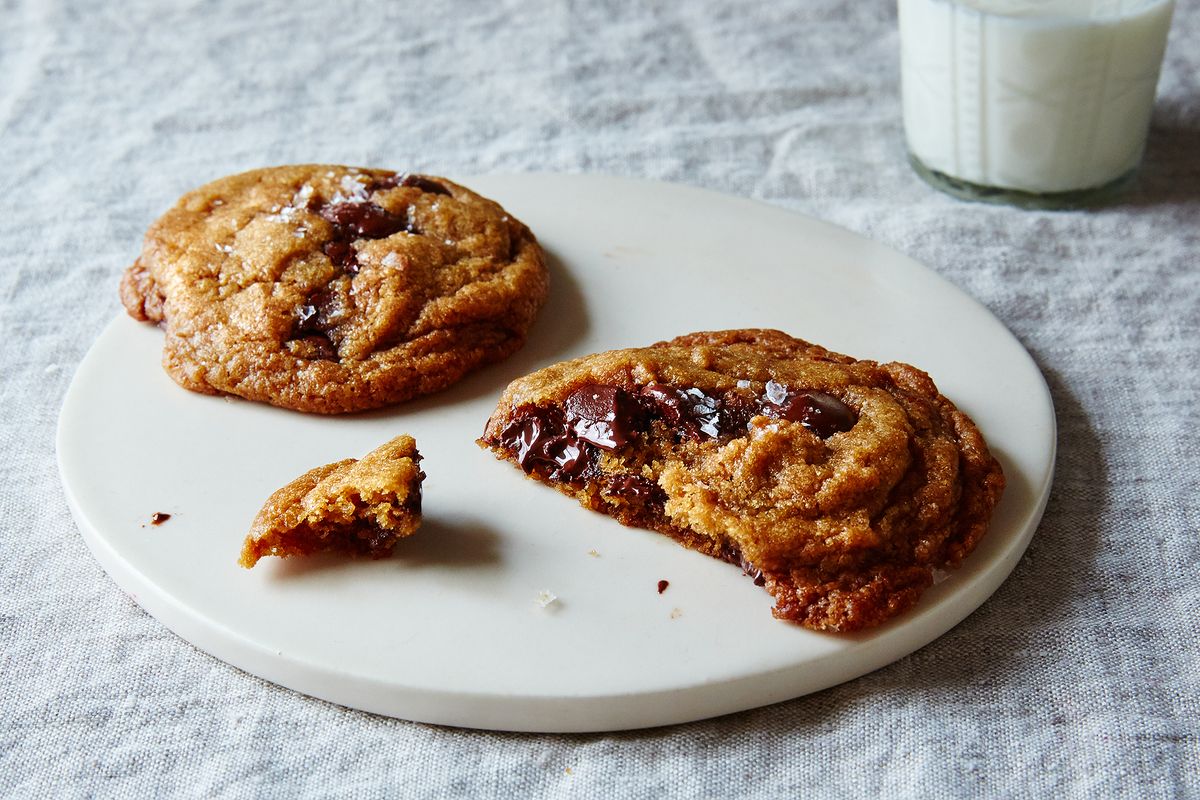This post originally appeared in Genius Recipes on Food52.
World, this is the genius chocolate chip cookie we’ve been waiting for. Oh, and one other thing: It’s vegan.
Notice that I didn’t say it’s genius for a vegan chocolate chip cookie or in spite of it. This cookie, which comes from Ovenly founders Agatha Kulaga and Erin Patinkin, can rest entirely on its own merits: its soft-bellied, chewy, caramelly-crisp-edged, rippled and ringed and puddled with melty chocolate, well-salted, incidentally vegan merits.
I realize this is almost incomprehensible if you grew up, like I did, making chocolate chip cookies by beating soft butter with sugar, then dropping in eggs one by one, ignoring what everyone says about eating cookie dough. But I’ve come to understand some of the kitchen science at work. We’ll get to that, because you’re going to want some talking points.
Even if you’re not vegan, sometimes you’re out of eggs. Or your butter isn’t soft (or, whoops, way too soft). Or you have a new friend or in-law who’s allergic to eggs or dairy. Of course, for the people who’ve been limited to other vegan cookies until now, this recipe is especially miraculous. “No fewer than three clients have now mentioned them to me as being extraordinary and the best,” our Vegan cookbook author and columnist (and nutritionist) Gena Hamshaw wrote to me when she tipped me off to the recipe.

Food52 / James Ransom
Maybe that’s because of the ingredients in other vegan chocolate chip cookies, which are likely to make them taste like a loose, disappointing approximation of the real thing — here are a few examples from the first few pages of Google:
- coconut oil
- arrowroot starch or cornstarch
- almond milk
- vanilla soy milk
- unsalted nonhydrogenated margarine
- flax egg
- unsweetened applesauce
Instead, Ovenly’s recipe uses pretty much standard chocolate chip cookie ingredients, except that they replace the egg and butter (which are largely made up of fat and water) with oil and water (same).
The technique is, if anything, simpler, since there’s no waiting for butter to soften or two-stage creaming involved — just a vigorous whisking of all the wet ingredients before adding the dry. But there is one crucial extra step: “The dough has to be refrigerated for at least 12 hours and up to 24 hours before being scooped. I know, it’s tempting to skip this step. DON’T,” Kulaga wrote to me.
You might have already learned about the dough-refrigerating trick in David Leite’s famous New York Times article from 2008, in which he revealed that all of the top bakeries in Manhattan agree that resting — or hydrating — your dough for a day or three makes for better cookies. The flavor is richer and more developed; the texture smoother, more nuanced, and further away on the spectrum from raw flour.
But the ultimate recipe he settled on, based on Jacques Torres’, had quite a few hurdles — as brilliant as it was. It called for both bread flour and cake flour, and pricey chocolate fèves, and the dough was at its best 72 hours after mixing. Because Ovenly’s cookie dough has no egg to slow down the hydration, it hits its peak much faster.

Food52 / James Ransom
I tried to break this recipe, Food Lab-style. I’ve made it with both vegan sugars and regular granulated ones (here, I made it with an especially dark brown vegan sugar, which made them a bit flatter, more toffee-colored, and more ripply than the ones Ovenly sells).
I’ve alternately frozen the dough for 10 minutes after scooping and skipped that step; I’ve baked on parchment and bare; I’ve let the cookies cool on the baking sheet and on a rack; I’ve hand-whisked and whipped on high speed in a stand mixer to varying degrees of whippedness. I’ve forgotten a quart of the dough in my purse for hours, then quickly scooped and froze the dough to pretend it hadn’t happened. The cookies have always been some version of wonderful.
I’ve even baked off the dough straightaway after mixing it (I’m sorry, Agatha! I’m sorry, Erin!). This was the biggest, and perhaps only noticeable, difference — the flavor a bit more flat, the texture a tad coarser. But I fed a lot of these to a lot of coworkers and there wasn’t a problem.
What I found was that these cookies are pretty indestructible, which is more than you can say for most unvegan ones. It’s easy to think there’s something more than kitchen science at play. As Patinkin told me, “There’s no bigger compliment than hearing, ‘If this cookie isn’t made with butter, then it must be made with magic.'”

Food52 / James Ransom
Ovenly’s Secretly Vegan Salted Chocolate Chip Cookies
Adapted slightly from Ovenly: Sweet and Salty Recipes from New York’s Most Creative Bakery by Erin Patinkin & Agatha Kulaga (Harlequin, 2014)
Makes approximately 18 cookies
Ingredients
- 2 cups (250 grams) all-purpose flour
- 1 teaspoon baking powder
- 3/4 teaspoon baking soda
- 1/2 teaspoon fine salt
- 1 1/4 cups dark chocolate chips (we prefer chocolate with 60 percent cocoa content or higher)
- 1/2 cup (100 grams) sugar
- 1/2 cup (110 grams) packed light brown sugar
- 1/2 cup plus 1 tablespoon canola oil
- 1/4 cup plus 1 tablespoon water
- Coarse-grained sea salt or flaky sea salt like Maldon, for garnish
Directions
- In a large bowl, whisk together flour, baking powder, baking soda, and salt. Add the chocolate chips to the flour mixture and toss to coat.
- In a separate large bowl, whisk the sugars briskly with the canola oil and water until smooth and incorporated, about 2 minutes. Note: Use fresh, soft light brown sugar. If there are clumps, break them up with the back of a spoon or your hand before whisking.
- Add the flour mixture to the sugar mixture, and then stir with a wooden spoon or a rubber spatula until just combined and no flour is visible. Do not overmix.
- Cover with plastic wrap. Refrigerate the dough for at least 12 hours and up to 24 hours. Do not skip this step.
- Preheat the oven to 350° F. Line two rimmed sheet pans with parchment paper. Remove dough from the refrigerator and use an ice cream scoop or a spoon to portion dough into 2-inch mounds. We recommend freezing the balls of dough for 10 minutes before baking as the cookies will retain their shape better while baking.
- Sprinkle the balls of dough with coarse-grained sea salt (if freezing, remove balls of dough from the freezer first), and bake for 12 to 13 minutes, or until the edges are just golden. Do not overbake.
- Let cool completely before serving.
See the recipe (and save and print it) here.



